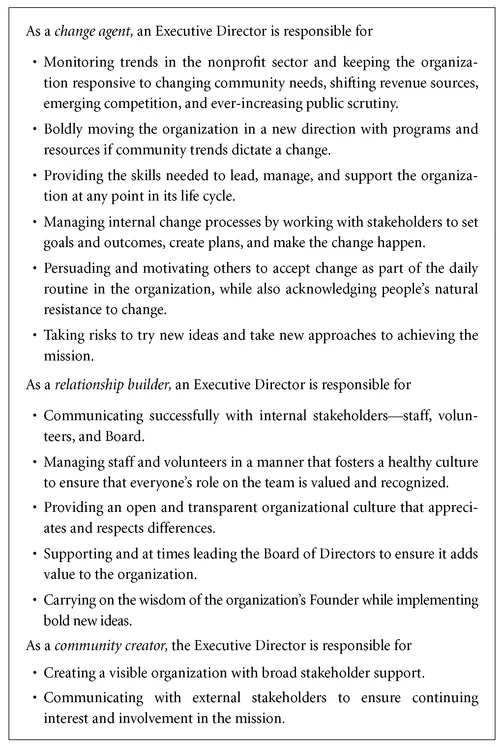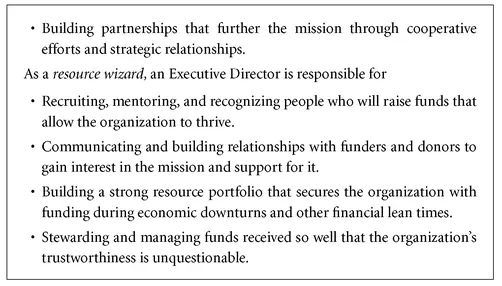
eBook - ePub
The Executive Director's Guide to Thriving as a Nonprofit Leader
- English
- ePUB (mobile friendly)
- Available on iOS & Android
eBook - ePub
The Executive Director's Guide to Thriving as a Nonprofit Leader
About this book
As the position of nonprofit ED becomes more demanding, there is a need for an up-to-date resource. This revised edition of the best-selling book is filled with management advice for succeeding as an executive director. This new edition includes thoroughly updated information and new content. It covers topics on timely issues and practical strategies including: Avoiding Burnout, Accountability, Professional Networking, Financial Literacy, Measuring Effectiveness, and much more. Ideal for ED's and board members, the book also includes new cases and stories from the field and "practical tips" sidebars.
Frequently asked questions
Yes, you can cancel anytime from the Subscription tab in your account settings on the Perlego website. Your subscription will stay active until the end of your current billing period. Learn how to cancel your subscription.
At the moment all of our mobile-responsive ePub books are available to download via the app. Most of our PDFs are also available to download and we're working on making the final remaining ones downloadable now. Learn more here.
Perlego offers two plans: Essential and Complete
- Essential is ideal for learners and professionals who enjoy exploring a wide range of subjects. Access the Essential Library with 800,000+ trusted titles and best-sellers across business, personal growth, and the humanities. Includes unlimited reading time and Standard Read Aloud voice.
- Complete: Perfect for advanced learners and researchers needing full, unrestricted access. Unlock 1.4M+ books across hundreds of subjects, including academic and specialized titles. The Complete Plan also includes advanced features like Premium Read Aloud and Research Assistant.
We are an online textbook subscription service, where you can get access to an entire online library for less than the price of a single book per month. With over 1 million books across 1000+ topics, we’ve got you covered! Learn more here.
Look out for the read-aloud symbol on your next book to see if you can listen to it. The read-aloud tool reads text aloud for you, highlighting the text as it is being read. You can pause it, speed it up and slow it down. Learn more here.
Yes! You can use the Perlego app on both iOS or Android devices to read anytime, anywhere — even offline. Perfect for commutes or when you’re on the go.
Please note we cannot support devices running on iOS 13 and Android 7 or earlier. Learn more about using the app.
Please note we cannot support devices running on iOS 13 and Android 7 or earlier. Learn more about using the app.
Yes, you can access The Executive Director's Guide to Thriving as a Nonprofit Leader by Mim Carlson,Margaret Donohoe in PDF and/or ePUB format, as well as other popular books in Betriebswirtschaft & Non-Profit- & gemeinnützige Organisationen. We have over one million books available in our catalogue for you to explore.
Information

PART ONE
Finding Your Way as Executive Director
The leader beyond the millennium will not be the leader who has learned the lessons of how to do.... The leader of today and the future will be focused on how to be ... how to develop quality, character, mind-set, values, principles, and courage.—Frances Hesselbein
A career in the nonprofit sector equates to an unspoken calling for many. You have a strong desire to make your community and world a little better or brighter. You are driven to explore the good as well as the bad that humankind has to offer. You want to manifest your lifelong focus and interest—your vocation—to the benefit of others.
Wrapped around these qualities is a new breed of servant-leader, manager, visionary, change agent, relationship builder, and resource wizard.
The nonprofit CEO—the Executive Director—is someone who appears to effortlessly juggle multiple responsibilities, relationships, and stakeholder interests while keeping both eyes fixed on the mission and bottom line. If you allow the nonprofit leader position to consume your life, it will. There is no end to the challenges and opportunities of being an Executive Director.
The reality is that nonprofit leadership is one of the most personally rewarding yet professionally complex career opportunities to be found. It is not for the weak of heart. Those looking to leave behind the politics of government work or the changing economic whims of the business sector will find no safe haven here. As a colleague recently paraphrased the old saying, “The ED job isn’t rocket science; it is much harder than that. Rocket science at least comes with precise formulas, mathematics, and laws of physics that result in a visible outcome.”
Can any Executive Director handle all the important tasks of the position effectively and still hope to have a life beyond the nonprofit? We believe that the answer is yes, and the chapters in Part One uncover some of the ways to make this possible. In Chapter One we take a close look at the unique job of the Executive Director and identify the characteristics critical to doing that job well. Chapter Two offers ways for Executive Directors to increase their effectiveness through professional development—and find the time to do so. Chapter Three offers insights and possibilities for leading a balanced life as an Executive Director. We know this is an unheard-of concept for many, but we believe wholeheartedly that a balanced life is possible!

chapter ONE
Understanding This Big Job
Leaders at all levels and in all situations must pay close attention to situations in which their most effective option is to follow ... because performance requires them to rely on the capacities and insights of other people.—Douglas K. Smith, “The Following Part of Leading,” Leader of the Future
Executive Directors have a very big job! If you are currently working as an Executive Director, or have done so in the past, you surely know just how big and complex the position is. You converse with funders and donors, inspire and manage staff, keep Board members informed and involved, listen to clients, raise money, review (and often worry about) finances, and articulate the case for your programs and the organization’s accomplishments; you often serve as an accidental technology expert, facilities manager, or HR specialist, and sometimes you even clean the office. Your responsibilities seem to change depending on who needs what. You must be able to prioritize a variety of stakeholders in a multitude of different ways. And no matter how well you plan and prioritize your day or week, something unexpected always occurs to draw your attention.
Because of all these responsibilities, Executive Directors must lead, manage, and support others to be successful. We believe that by knowing when to be a leader, manager, or supporter, you can more efficiently focus your efforts, and in many cases delegate to others. As a result you can make more time for a life beyond the nonprofit. In this chapter, we answer these questions:
- What are the roles and responsibilities of an Executive Director?
- What is the difference between a leader and a manager?
- When should an Executive Director lead, manage, or support others?
WHAT ARE THE ROLES AND RESPONSIBILITIES OF AN EXECUTIVE DIRECTOR?
All Executive Directors (paid or unpaid) share one universal role, regardless of where they work. The Board always hires the ED as a temporary caretaker of the mission, entrusting the organization to the ED with the expectation that it will thrive in that person’s care. So the Executive Director does not own the nonprofit but is charged by the Board with controlling its operations and course while making it thrive. The Executive Director is the key caretaker of the nonprofit.
To perform this central caretaker role, an Executive Director must have five important characteristics. The strength of each will differ from person to person, but every Executive Director needs all of the following in some combination:
- Visionary
- Change agent
- Relationship builder
- Community creator
- Resource wizard
These characteristics will look different in each person—and in each non-profit. In some nonprofits, all five characteristics may need to be in evidence all the time, while in others they ebb and flow in the Executive Director depending on the needs of the organization.
Throughout the remainder of the book, we will be describing these characteristics in great detail and offering you ideas on how to apply them in your non-profit. First, though, to understand them more fully, it’s helpful to look at the five in terms of the Executive Director’s responsibilities.
The characteristics of an Executive Director are manifested and become apparent in the responsibilities of the position. These responsibilities generally are listed in the job description or work plan for the ED. They vary from person to person and nonprofit to nonprofit, depending on the size and culture of the organization and where it is in its life cycle. Exhibit 1.1 highlights the key responsibilities of an Executive Director and should be viewed as an illustration of what most EDs are responsible for in most organizations. You may find it helpful to use this chart to create a more specific list of responsibilities for you in your own nonprofit.



Exhibit 1.1 Responsibilities of an Executive Director
The list of responsibilities in the exhibit may seem daunting to anyone who has not experienced the job of an Executive Director. The list is long, particularly when you think about the specific tasks needed for each responsibility. Remember, though, that not all responsibilities have highest priority on any given day.
In some smaller organizations that have no paid staff, the Executive Director may struggle to accomplish any of the indicated responsibilities because of the need to handle routine tasks normally performed by others in larger organizations. In this case, an ED needs to remember the core responsibilities as listed here, and work diligently to delegate as much of the other work as possible to volunteers. As an example, one Executive Director who was the only employee in her nonprofit was struggling to keep donors informed of the innovations taking place in programs. Her role as “community creator” was hampered by poor external communication systems. She enlisted two volunteers who had a background in marketing communications, and they redesigned the Web site, opened a Facebook page, set up the nonprofit on Twitter, and agreed to update and manage these communication tools so the ED could do other tasks.
Being a successful Executive Director is a learned role—no one starts out in the position as the “perfect ED.” In fact, successful Executive Directors are always improving themselves and taking time to build and strengthen the skills most needed to fulfill their responsibilities and lead their nonprofit to greater success. Remember this if you find yourself doubting your capabilities or feeling inadequate. The very big job of an Executive Director requires an ongoing process of learning and development. We discuss this further in Chapter Two and throughout the book.
It is also important to realize that, most often, the job is not about you. For instance, an ED working at 150 percent and still struggling to juggle all the responsibilities of the position is probably doing an excellent job—but simply has too much to do, or the organizational systems are not in place to support the position. This is actually true for most Executive Directors, and too many choose to find some fault with themselves for their inadequacy. Understand that you are not inadequate, the position is just enormous. Much of Chapter Three w...
Table of contents
- Cover
- Title
- Copyright
- The Jossey-Bass Nonprofit Guidebook Series
- Other Titles in The Jossey-Bass Nonprofit Guidebook Series
- Table of Exhibits
- PREFACE
- ACKNOWLEDGEMENTS
- THE AUTHORS
- PART ONE: Finding Your Way as Executive Director
- PART TWO: Executive Director as Visionary
- PART THREE: Executive Director as Change Agent
- PART FOUR: Executive Director as Relationship Builder
- PART FIVE: Executive Director as Community Creator
- PART SIX: Executive Director as Resource Wizard
- PART SEVEN: Leadership in Transition
- CONCLUSION
- RESOURCES
- INDEX
- End User License Agreement